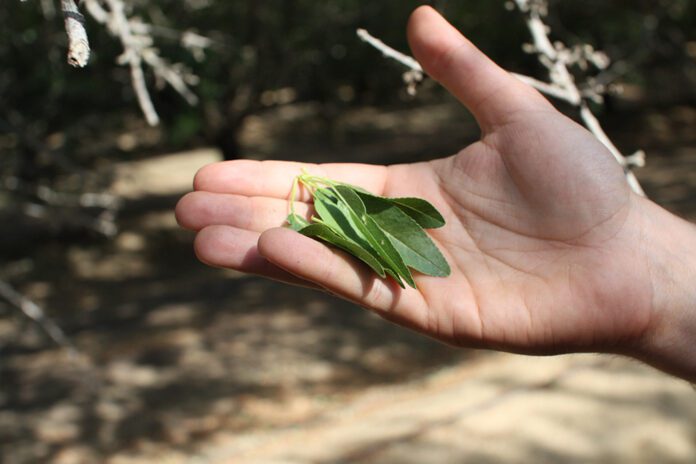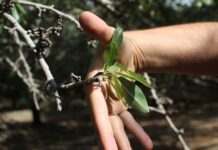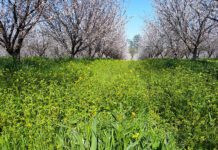As the name implies, micronutrients are only needed by plants in small quantities, compared to macronutrient plant demand. But these nutrients are listed among the 17 essential plant nutrients needed for healthy plant growth. Just because plants only require small quantities of micronutrients doesn’t mean they should be ignored in development of nutrition programs. Micronutrients play vital roles for plant photosynthesis, respiration, enzyme function, chlorophyll synthesis and metabolic processes.
Micronutrients promote growth that produces higher yields and crop quality. Balanced nutrition for trees also translates into maximizing the genetic potential of the rootstock and variety. Micronutrient availability is vital. Even if they can be found in the root zone of the tree, they may not be in a chemical form that can be taken up by the roots. The solubility of several nutrients lowers as the pH level increases, including iron, copper, zinc and manganese. When these nutrients are not soluble, they remain in solid forms plants cannot absorb.
When and how micronutrients can be taken up by the plant are determined by soil type and texture, pH and irrigation water.
On the flip side of deficiency, there is also toxicity to an oversupply of a micronutrient. Toxicity can cause low yields and poor growth. The range between an adequate supply and more than the plant needs can be small.
The top five micronutrients needed for tree nut orchards, identified by UC farm advisors, researchers and crop consultants, are zinc, boron, manganese, iron and copper.
1. Zinc
Zinc is important for enzyme activation, protein synthesis and carbohydrate metabolism. It also is needed for synthesis of auxins,or plant hormones necessary for growth.
This micronutrient is very soil pH-dependent, Sebastian Saa, associate director of agricultural research for Almond Board of California, said. Deficiency of Zn can lead to stunted tree growth, and reduced yields. Signs of Zn deficiency in trees include poor leaf development, flowers and fruiting bodies.
Saa stressed Zn does not translocate and is immobile in the plant. Zn deficiency becomes apparent in the spring with onset of symptoms in mid- to late season. Delayed bud opening, terminal leaves that are small and yellow, wavy leaf margins and terminal dieback are all signs of Zn deficiency.
Alkaline soils reduce its availability to plants, Saa noted, and is the reason why foliar applications work better in almond than soil-applied Zn.
Soil tests and leaf sampling can deliver an accurate picture of Zn needs and availability. Saa said historically, Zn is applied in the fall, but that this is not a very efficient way to add Zn to the plant due to its poor remobilization. He pointed applications early in the season may be more appropriate.
Zn is applied in the form of salts or chelates or citric acid. Saa said chelates provide a shield to the molecule so it remains available for a longer time when applied to the soil. Zn sulfate is an inexpensive source, he said, but can be toxic.
2. Manganese
Mn is used in photosynthesis, respiration and nitrogen metabolism. It also activates enzymes that are essential for the synthesis of chlorophyll and the reduction of nitrates to amino acids.
John Post, president of Live Oak-based Ag Advisors, said deficiency of this micronutrient is rare as most soils have plenty. High-pH or waterlogged soils affect it’s availability to plants.
While a deficiency may have no significant effect on production, it can cause a decrease in chlorophyll production affecting photosynthesis. Leaf chlorosis due to a deficiency is not as intense as a Zn deficiency. It appears between the veins of the leaf, not on the margin of the leaf.
If a Mn deficiency is suspected, leaf and soil samples should be analyzed. Application of 2 lbs manganese sulfate per 100 acres is an effective corrective method, Post said.
Toxicity can be a bigger problem with manganese. Orchards, particularly walnut, planted in sandy, highly acidic soils and irrigated with surface water can have serious production issues as a result of high levels of Mn. In these acidic soil situations, applying lime to increase pH and tie up Mn can be an effective strategy.
3. Boron
This micronutrient is tricky depending on the tree species, but it plays an important role in tree health. Doug Amaral, UCCE water and soils area advisor in Kings and Tulare counties, said B levels in soil or water can be a limiting factor in almond production. Pistachio trees have a higher tolerance level for B, and it is rare to see symptoms of B toxicity in pistachio.
B is needed by plants for cell wall formation, pollen germination and fruit set. Deficiency of this micronutrients can result in abnormal growth, reduced flowering and poor nut set. It affects the development of both vegetative and reproductive structures, leading to decreased yield.
B is immobile in pistachio. Once it is taken up and transported to leaves, it stays there. In almond, B is mobile. Severe deficiencies show as shoot tip dieback. Internal gumming is a symptom of mild deficiencies. Severe toxicity will cause gumming in the trunk.
Groundwater high in B used for irrigation can cause toxicity. In almond, high B levels can cause fruit drop. Some almond rootstocks can also pick up B deep below the soil surface. Unlike other tree nuts, soil and leaf sample analyses do not give a true picture of B levels in almond. Amaral said hulls need to be tested for B. If B in hulls is below 80 ppm, a soil application of B is warranted. In the 80- to 120-ppm range, a foliar application is recommended.
In pistachio, B deficiency shows up as cupped and deformed leaves. Flower panicles can drop in severe cases. Foliar sprays will only affect the current season’s growth, and if deficiencies are severe, a soil application is needed.
West Central Valley soils tend to have higher B levels. On the east side, deficiencies in pistachio may occur due to acidic soils and higher quality irrigation water.
4. Copper and 5. Iron
Deficiency or toxicity issues with these two micronutrients tend to be sporadic, Amaral said, and related to specific situations, including a high water table that changes soil chemistry. In the case of Fe, a deficiency is more likely due to soil conditions that reduce its availability to plants. Soils high in phosphorous, Cu, Mn and Zn can reduce Fe availability. It is difficult for trees to take up adequate Fe in alkaline soils.
Fe is essential for building chloroplasts. This micronutrient also plays a role in synzyme systems for respiration and nitrogen fixation.
Deficiencies are visible as veinal chlorosis and can lead to decrease in tree yield.
Deborah Miller of Deerpoint Group said Cu is needed for disease resistance, providing the tree with more stamina to resist stress. It is common and often not treated, Miller added.
The range between Cu toxicity and deficiency is narrow. Soil- or foliar-applied Cu should be based on leaf analysis. It is important, Miller said, that leaf samples are taken prior to any spray applications.

Cecilia Parsons | Associate Editor
Cecilia Parsons has lived in the Central Valley community of Ducor since 1976, covering agriculture for numerous agricultural publications over the years. She has found and nurtured many wonderful and helpful contacts in the ag community, including the UCCE advisors, allowing for news coverage that focuses on the basics of food production.
She is always on the search for new ag topics that can help growers and processors in the San Joaquin Valley improve their bottom line.
In her free time, Cecilia rides her horse, Holly in ranch versatility shows and raises registered Shetland sheep which she exhibits at county and state fairs during the summer.
















